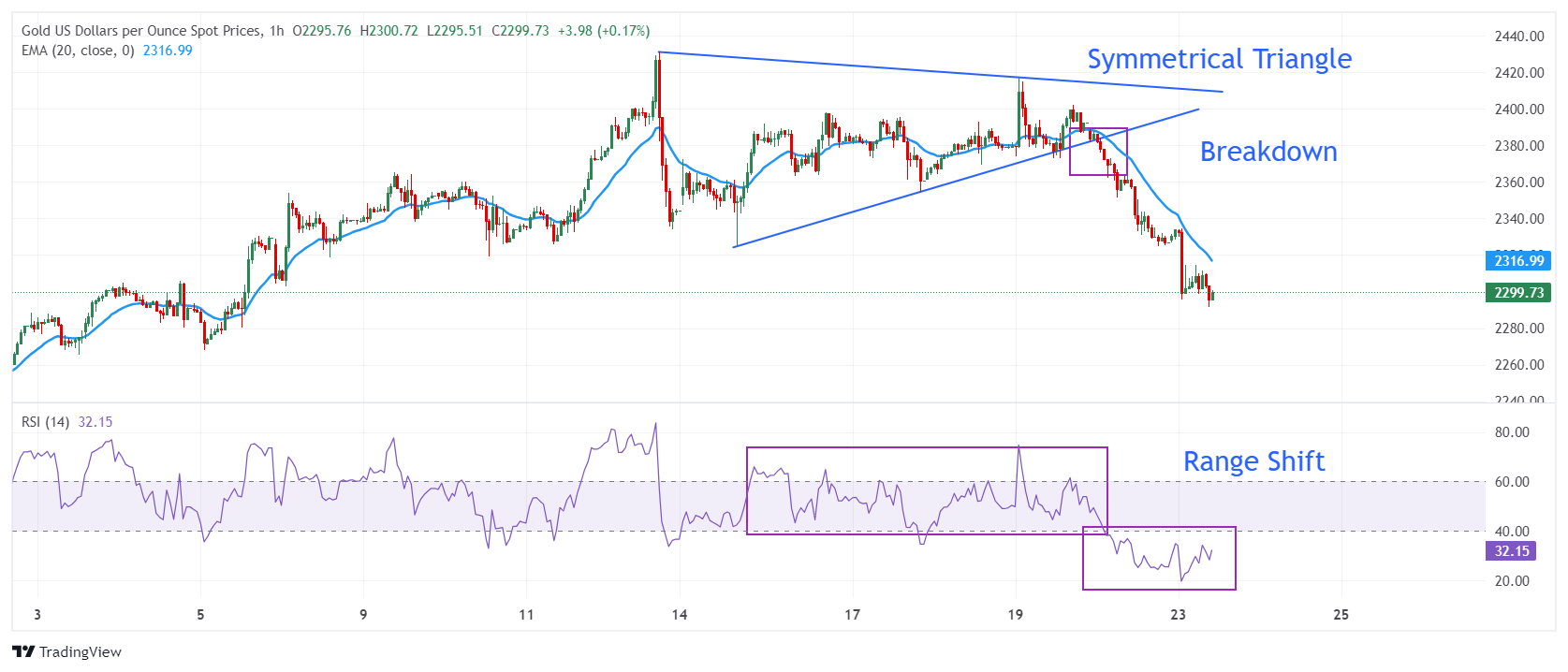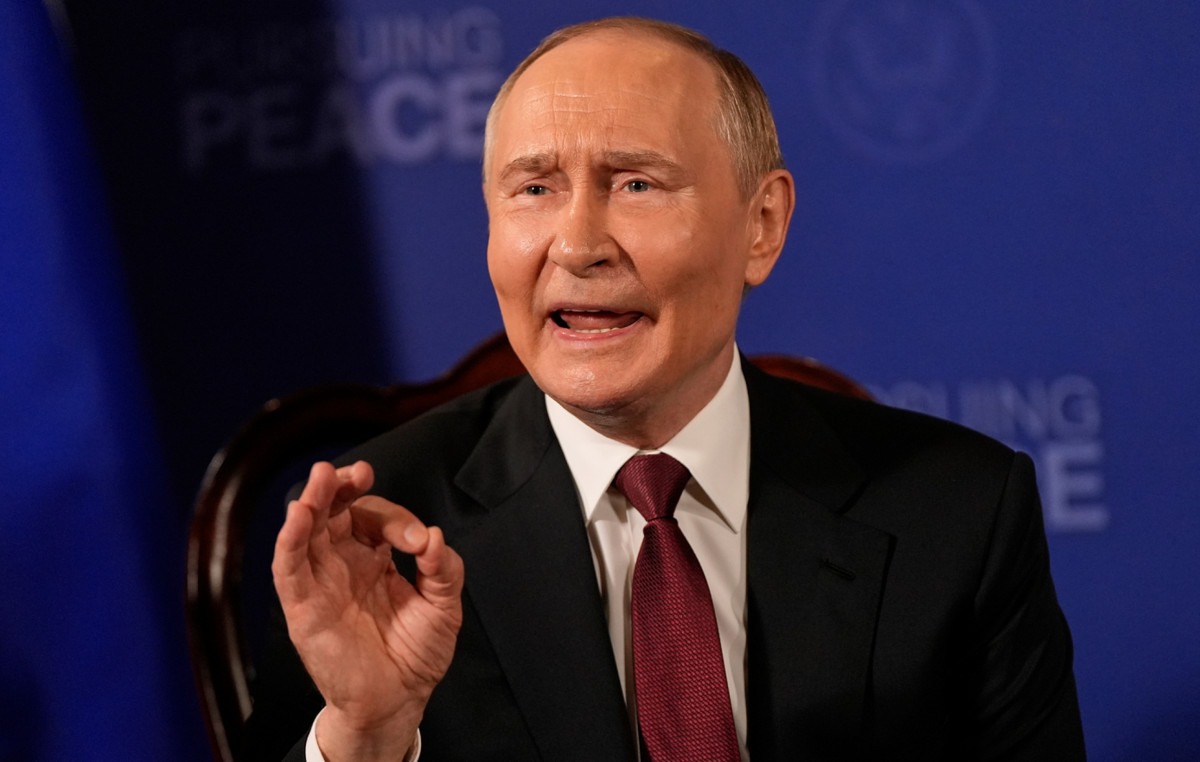- The price of Gold falls to around $2,300, as fears of an escalation of the conflict in the Middle East dissipate.
- The attractiveness of the US dollar improves amid the solid economic outlook for the United States.
- The Fed supports keeping interest rates higher until inflation is confident that it will return to 2%.
The price of Gold (XAU/USD) extends its bearish trend for the second consecutive day, trading slightly below the crucial support of $2,300 in the American session on Tuesday. The precious metal enters bearish territory as investors shy away from fears about the Middle East amid hopes that the conflict between Iran and Israel will not escalate further. This has improved investors' risk appetite, while safe-haven demand has decreased.
Gold's outlook becomes vulnerable as the 10-year US Treasury yield rises to 4.64%. Meanwhile, investors are focused on US personal consumption expenditure (PCE) price index data for March, due to be released on Friday. The inflation data will give clues about the guidance of the Federal Reserve (Fed) regarding interest rates at the monetary policy meeting in May, in which policymakers are expected to keep them unchanged in the range of 5.25 %-5.50%. The Fed's preference to keep interest rates rising bodes well for US bond yields and weighs on Gold.
The US Dollar Index (DXY), which tracks the value of the US dollar against six major currencies, falls below 106.00 as S&P Global released weak preliminary PM I data for April. The agency showed that the manufacturing PMI surprisingly fell sharply to 49.9 from expectations of 52.0 and the previous reading of 51.9. A reading below 50.0 is itself considered a contraction. Likewise, the Services PMI, which represents the services sector, which accounts for two-thirds of the economy, drops surprisingly to 50.9 from expectations of 52.0 and the previous reading of 51.7. A sharp decline in PMI indicates weakness in household spending or reduction in inventories by homeowners.
Daily summary of market movements: Gold price continues to fall as US bond yields rise
- Gold falls below the crucial support of $2,300 as safe haven demand dissipates amid easing tensions in the Middle East. Israel's limited retaliatory strike in Isfahan against the hundreds of missiles and drones launched in its state on April 13, as well as Iran's failure to plan an immediate response, indicate that both nations are not interested in expanding the conflict.
- Aside from that, the recent hawkish guidance from Federal Reserve policymakers on interest rates has also weighed on Gold. Fed policymakers believe that the current monetary policy framework is appropriate, given that inflation is has remained stubbornly high in the first three months of this year and demand for labor remains strong.
- Fed officials are expected to keep interest rates at their current levels until they are confident that inflation will fall to the 2% target. Traders currently expect the Fed to begin cutting interest rates as early as the September meeting. This week, investors will focus on US core PCE price index data, which will influence Fed rate cut expectations.
- Monthly core PCE is estimated to have grown 0.3%, with annual figures slowing to 2.6% from 2.8% in February. The core PCE is the Fed's preferred inflation measure because it excludes food and energy price volatility. Softer-than-expected US inflation figures would raise expectations of an early rate cut by the Fed, which would help Gold hold firm. On the contrary, persistent or higher than expected numbers will likely weigh on Gold prices.
- Ahead of the US PCE core inflation data, investors will focus on the preliminary first quarter Gross Domestic Product (GDP), which shows the performance of the US economy over the period. The economy is expected to have expanded at an annualized pace of 2.5%, slower than the 3.4% increase seen in the final quarter of 2023.
Technical analysis: The price of Gold falls to close to $2,300

Gold price is facing intense selling after a breakout of the symmetrical triangle formation on the hourly time frame. The precious metal falls below $2,300 as the bearish breakout of the aforementioned formation triggers volatility, resulting in broader bearish ticks and heavy selling volume.
The 20-period EMA at $2,317 acts as the main roadblock for the Gold price bulls. The 14-period RSI has produced a range shift from the 40.00-60.00 territory to the 20.00-40.00 region. , indicating that bearish momentum has been triggered.
Frequently asked questions about Gold
Why invest in Gold?
Gold has played a fundamental role in human history, as it has been widely used as a store of value and medium of exchange. Today, apart from its brilliance and use for jewelry, the precious metal is considered a safe haven asset, meaning it is considered a good investment in turbulent times. Gold is also considered a hedge against inflation and currency depreciation, since it does not depend on any specific issuer or government.
Who buys more Gold?
Central banks are the largest holders of Gold. In their aim to support their currencies in turbulent times, central banks tend to diversify their reserves and purchase Gold to improve the perception of strength of the economy and currency. High Gold reserves can be a source of confidence for the solvency of a country. Central banks added 1,136 tons of gold worth about $70 billion to their reserves in 2022, according to data from the World Gold Council. This is the largest annual purchase since records exist. Central banks in emerging economies such as China, India and Türkiye are rapidly increasing their gold reserves.
What correlation does Gold have with other assets?
Gold has an inverse correlation with the US Dollar and US Treasuries, which are the main reserve and safe haven assets. When the Dollar depreciates, the price of Gold tends to rise, allowing investors and central banks to diversify their assets in turbulent times. Gold is also inversely correlated with risk assets. A rally in the stock market tends to weaken the price of Gold, while sell-offs in riskier markets tend to favor the precious metal.
What does the price of Gold depend on?
The price of Gold can move due to a wide range of factors. Geopolitical instability or fear of a deep recession can cause the price of Gold to rise rapidly due to its status as a safe haven asset. As a non-yielding asset, the price of Gold tends to rise when interest rates fall, while rising money prices tend to weigh down the yellow metal. Still, most of the moves depend on how the US Dollar (USD) performs, as the asset is traded in dollars (XAU/USD). A strong Dollar tends to keep the price of Gold in check, while a weaker Dollar is likely to push up Gold prices.
Source: Fx Street
I am Joshua Winder, a senior-level journalist and editor at World Stock Market. I specialize in covering news related to the stock market and economic trends. With more than 8 years of experience in this field, I have become an expert in financial reporting.







